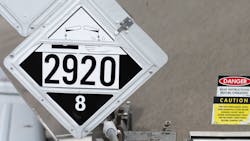National Tank Truck Carriers and American Trucking Associations reaffirmed their support for utilizing electronic shipping papers in hazardous materials transportation in comments filed Oct. 23 in response to the Pipeline and Hazardous Materials Safety Administration’s request for information regarding hazard communication alternatives.
The two trucking associations first petitioned the agency to “without delay” develop rulemaking that allows motor carriers to use electronic documents for hazmat shipments in a joint letter to PHMSA in November, 2020, as their members sought ways to reduce physical contact between individuals during the COVID-19 pandemic.
But PHMSA has been considering the use of electronic hazmat shipping documents since at least 2009.
“NTTC and ATA ask that PHMSA amend 49 CFR § 177.817, 49 CFR §§ 172.201-172.205, and related regulations to the extent that those provisions require the shipping paper to accompany the shipment by being physically present on the vehicle,” association leaders stated in their most recent comments addressed to William Schoonover, PHMSA’s associate administrator.
“Both NTTC and ATA seek new requirements for shipments by motor carrier that are similar or identical to those in 49 CFR § 172.201(a)(5), which specifically authorizes rail carriers to accept shipping paper information from an offeror of hazardous materials either telephonically or electronically (EDI).”
See also: PHMSA considers authorizing electronic hazmat communications
According to PHMSA’s request for information notice, the agency is considering revisions to the Hazardous Materials Regulations (HMRs) that would authorize a performance-based electronic alternative to the existing physical, paper-based hazard communication requirements for motor carriers. The revision is meant to facilitate and promote the use of electronic hazard communication across all modes of transportation.
Regulations currently require hazard communication be maintained as physical, printed documents during over-the road transport. However, widely adopted technologies could supplement or replace the existing paper-based hazard communication system, and offer opportunities for improved emergency response and oversight, as well as increased efficiency in the operations of transportation networks, NTTC and ATA maintained.
PHMSA’s request also posed several questions about the feasibility of a centralized information database, which NTTC and ATA indicated they don’t “explicitly endorse” because of the security risks involved. “Bad actors” potentially could access customer information on bills of lading, or “weaponize” hazmat shipment data if the database isn’t properly secured. However, most trucking companies believe security concerns are not extensive enough to render them unwilling to participate in electronic hazard communication, they said.
“Allowing drivers to save shipping papers via electronic format can be as simple as saving a file as a PDF in electronic format on their smartphone or tablet,” association leaders argued. “In the event of an incident, this option would allow a driver to provide the electronic shipping paper to first responders without the need for cellular connectivity or a password/biometric lock. Likewise, in the event of an incident where the driver is expediting their exit from the cab of the truck, we feel it more likely that the driver would exit with their smartphone or tablet—versus physical copies of shipping papers.
“These instances would not require the use of a centralized database.”
Operational efficiencies associated with electronic hazard communication also would include “immediate” cost savings, the associations asserted.
“A single shipment of hazardous materials bill of lading and emergency response information is currently printed on multiple pages that could easily exceed 20 pages,” the letter stated. “In an industry where the burden of paperwork has been identified by governing agencies, electronic documents would aid in reducing operating costs by eliminating the need to print bills of lading, safety data sheets, and certificates of analysis, saving costs to paper, printer, copier, toner, disposal and maintenance costs.
“Additionally, funding for the procurement and maintenance of machines such as printers, scanners, and shredders can be saved as such technologies may be reduced in a trucking company’s office.”
About the Author

Jason McDaniel
Jason McDaniel, based in the Houston TX area, has nearly 20 years of experience as a journalist. He spent 15 writing and editing for daily newspapers, including the Houston Chronicle, and began covering the commercial vehicle industry in 2018. He was named editor of Bulk Transporter and Refrigerated Transporter magazines in July 2020.
